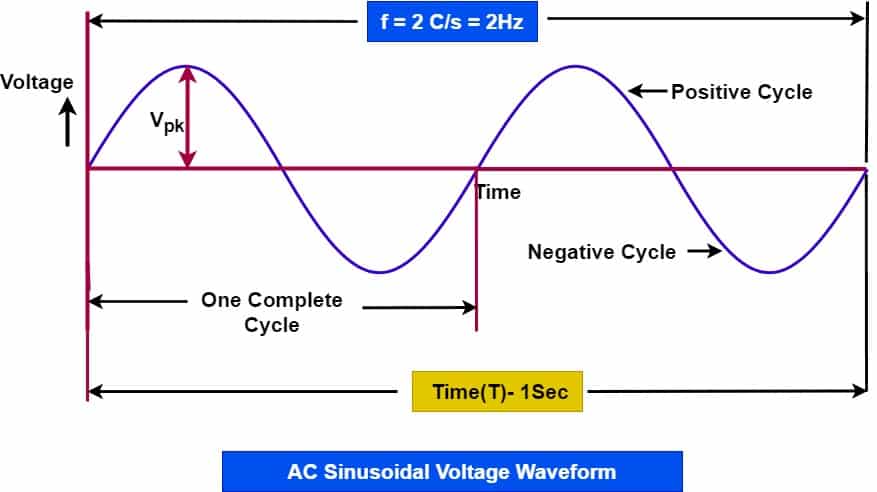Definition of frequency-The number of periodic oscillations completed in one unit time is called the frequency. The oscillatory signal completes the number of repeating events in a definite time period. The frequency is used for defining rotation per cycle of wave, oscillation, and rotation.
The SI unit of frequency is Hertz (Hz). Hertz is named after the German physicist Heinrich Hertz, the first to broadcast and receive radio waves. Radio waves travel at one cycle per second (1 Hz). One oscillation means one complete cycle. Therefore, we can denote the frequency by cycles/second or revolution/second which is equal to 1 Hz. The wave has a frequency of 5 HZ, which means the wave completes 5 cycles in one second.
Example
A rotor of an induction motor rotates 1500 rounds in one minute. What is the frequency of rotation?
No of cycles or rotation = 1500
Time taken to complete 1500 rotation= 60 Minutes
= 60 X 60 =3600 Seconds
” Number of Cycles completed in one second is frequency”
Frequency = No. of Cycles/Time
= 1500/3600
= 0.41 rotation/cycle
f= 0.41 Hz
Frequency is widely used for electrical voltage and current in electrical AC circuits. In the case of electrical voltage and current, the voltage and the current waveform are sinusoidal, and a sine wave repeats the number of times a sine wave completes.
A sinusoidal waveform completes one cycle going through a positive to negative half cycle. The frequency of voltage is 50 Hz in India and 60 Hz in the US. Alternating voltage and current of 50 Hz frequency mean sine wave complete 50 cycles in one second.
Frequency of AC voltage and AC current
We can further understand the frequency of AC voltage and current with the help of a sinusoidal waveform. The various terms used for alternating voltage and current are as follows.
- Frequency Hertz (Hz) – 1 Hz = 1 Cycle/second
- Time period(T) – Time taken to complete one cycle [T= 1/f ]
- positive to negative cycle
If an alternating current or voltage has the frequency of 3 Hz (see diagram below), that indicates its waveform repeats 2 times in 1 second.

The more number of cycles per second means the more frequency.
Range of Frequency for Electrical Equipment
The various electrical equipment functions at different frequencies. The frequency used for equipment depends on the type of application. The frequency range of some of the electrical equipment are given below.
| Type of Equipment | Frequency Range |
| Power Line Frequency | 50 Hz to 60 Hz |
| Variable Frequency Drive( Carrier Frequency) | 1 Khz to 20 KHz |
| Audio Frequency Range | 15 Hz to 20 KHz |
| Very High Frequency | 30 to 300 MHz |
| Ultra High Frequency | 300 to 3000 MHz |
| Super High Frequency | 3 to 30 GHz |
| Extremely High Frequency | 30 to 300 GHz |
| Radio frequency | 30-300 kHz. |
| Low frequency | 300 kHz to 3 megahertz (MHz). |
| Medium frequency | 3-30 MHz. |
Importance of Frequency for Electrical Equipment
The frequency of AC power is very important. We design the electrical circuits and equipment to operate at a fixed frequency. The circuit components can work reliably at the frequency for which circuit components are designed. The frequency must remain within the specified range of 50 +/- 1.5 Hz.
The performance of the electrical equipment drastically deteriorated with under and over frequency from the specified frequency range. For example, an induction motor designed for 50 Hz, and if we feed more than 50 Hz frequency, then the speed of motor increase and correspondingly its torque decrease.
Types of Frequency
The frequency is broadly classified into two categories.
1. Angular Frequency
The angular frequency measures angular displacement per unit time. Its units is degrees (or radians) per second. The unit of angular frequency is Hertz. The relation between the frequency and angular frequency is ;

Where, ω – angular frequency in rad/second
If frequency is 50 Hz, then angular frequency is;
ω = 2πf = 2 x 3.14 x 50 =314 rad/second
We can represent the sinusoidal waveform as
ν = V0 Sinωt = V0 Sin 314t
Where,
ν = Instantaneous value of sine wave
V0 = Peak Value of sine wave
2. Spatial Frequency
It shows the characteristic of any structure that is the periodic cross position in space. SI unit of spatial frequency is cycles per meter. It is inversely proportional to the wavelength.
Related Posts